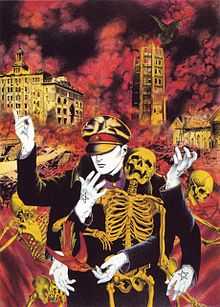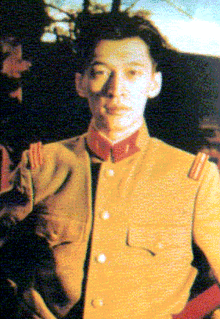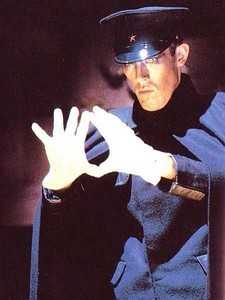Yasunori Katō
| Yasunori Katō | |
|---|---|
|
Katō as portrayed by Kyūsaku Shimada in the 1988 adaptation of Teito Monogatari.. | |
| First appearance | Teito Monogatari vol. 1 (1985) (Kadokawa Shoten) |
| Last appearance | The Great Yokai War (2005) (Kadokawa Shoten) |
| Created by | Hiroshi Aramata |
| Portrayed by |
Kyūsaku Shimada (Tokyo: The Last Megalopolis, Tokyo: The Last War, Doomed Megalopolis) Kazuhiko Nishimura (Teito Monogatari Gaiden) Etsushi Toyokawa (The Great Yokai War) Jeff Winkless (Doomed Megalopolis) |
Yasunori Katō (加藤 保憲 Katō Yasunori) is a fictional character, the protagonist [1][2] of the Japanese historical fantasy series Teito Monogatari, created by Hiroshi Aramata. He first appeared in a 1983 issue of a science fiction magazine published by Kadokawa Shoten[3] and has since gone on to be featured frequently in Japanese popular culture. His character is generally associated with onmyodo mysticism since Teito Monogatari was the first major novel to popularize the art in Japanese fiction.
In Japanese, he is commonly referred to as the "Majin" (魔人 Majin, Demon Man) due to his incredible superhuman abilities and near immortality.
Biography
Katō is a supernatural Melmoth the Wanderer-style figure with a mysterious past. He is described as an oni born from the grudge of 2000 years of Japan's hidden history. As his opponent Yasumasa Hirai, the official descendant of Abe no Seimei and leader of the true onmyoji who serve the Japanese Emperor explains:
From the viewpoint of onmyodo of the Tsuchimikado line, an oni is a transparent genie that onmyoji manipulate. The term oni means the indigenous people of the water or mountain. It could be a descendant of Chinese, Korean or naturalized Japanese who did not worship the imperial court...He [Katō] is a descendant of those who rebelled against the imperial court in ancient times. Katō is a villain who inherited the grudge and the heresy from them and will endanger the unbroken Japanese imperial line. He is probably not a Japanese subject.[4]
Katō is also a powerful onmyoji who manipulates oni.[4] Later on in the novel, his birthplace is determined to be Ryūjin, Wakayama and associations are made between his lineage and the tribal offshoots of Abe no Seimei's clan. In the 19th century, he enlists in the Imperial Japanese Army under the guise of a Japanese soldier and rises to the rank of First Lieutenant.
In Teito Monogatari, Katō reveals his true intentions to destroy Tokyo through any means possible in order to cripple the Japanese Empire. He joins forces with underground Chinese and Korean anti-Japanese oppression groups (such as Donghak Peasant Revolution) and continues to work behind the scenes of various periods of 20th century history to cause supernatural disasters which will weaken Japan. His first goal is to awaken the sleeping spirit of Taira no Masakado to help him cripple the country. However his plans branch off into feng shui territories, agonizing the firmament and earth dragons to cause earthquakes and other natural disasters. In 1927, his efforts are temporarily sabotaged by the powerful miko and priestess of Masakado, Keiko Tatsumiya.
In 1945, he is instrumental in the death of Franklin D. Roosevelt. The Japanese government organizes a plan to assassinate the Allied leaders through a Buddhist curse cast by abbot Otani Kozui, with their first target being Roosevelt. The Japanese Freemasons politically oppose the plan and attempt to sabotage the project. However Kato assassinates the leader of the Japanese Freemasons, allowing the curse to go to completion.
In 1960, Kato returns to Japan amidst the chaos of student protests against the signing of the Treaty of Mutual Cooperation and Security between the United States and Japan. There he befriends the eager young writer Yukio Mishima and subtly manipulates him to promote liberal agendas which will weaken Japan's political power. Eventually Mishima resists, culminating in his ritual suicide on November 25, 1970.
In 1998, Katō returns to stir up another earthquake under Tokyo by arousing the water dragon, Ryūjin. At this point in the story, Katō is defined as another version of Taira no Masakado himself. Just as Masakado sought to overthrow the current Japanese government, so does Katō seek to overthrow the Imperial authority by eliminating the capital Tokyo.[4]
Amidst the wreckage of the Imperial Capital, Kato and his allies contend with the remaining defenders of Tokyo, which include a resurrected Yukio Mishima and Keiko Tatsumiya's apprentice. After a long struggle, Kato is finally defeated.
Katō's past is more deeply explored in the spin-off novel Teito Monogatari Iroku. In this novel, it is also revealed that he is the last descendant in a long line of mystics. His predecessor was Jubei Katō, a character who's story is chronicled in the novels Teito Gendan and Shin Teito Monogatari.
In The Great Yokai War, Katō returns to Japan in 2005 with an army of monsters created from discarded objects infused with Yokai under his command in another attempt to destroy Tokyo. This time he is stopped by the efforts of a band of native yokai and a young boy wielding the power of the Kirin Rider. Despite being defeated, gaining Azuki bean-like pupils in the process, Katō survives the encounter and it is implied that at the end that he is ready to execute another plan.
Works appeared in
Literature
- Teito Monogatari (1985-1989)
- Teito Monogatari Gaiden (1995)
- Teito Gendan (1997)
- Shin Teito Monogatari (2001)
- Teito Monogatari Iroku (2001)
- The Great Yokai War (2005)
Stage
- Teito Monogatari (1985) by the Tokyo Grand Guignol Theater Company
Film
- Tokyo: The Last Megalopolis (1988)
- Tokyo: The Last War (1989)
- Teito Monogatari Gaiden (1995)
- The Great Yokai War (2005)
TV
- Kamen Rider Norida (Episode: "Horror! Teito Taisen Man!", 1989)
Manga
- BABYLON TOKYO (1987)
- Teito Monogatari (1987)
- Teito Monogatari: TOKIO WARS (1989)
Anime
- Doomed Megalopolis (1991-1992)
Appearance


The original character was simply described as a youthful military official with a handsome visage. The character evolved in popular culture though and his image began to change. In modern depictions, he is generally described as a tall man with an unnaturally long face. His classic outfit is composed of the traditional uniform of a Japanese Imperial officer, complete with a service dress, cap, gloves, sword and a cape. On the backs of his white gloves are red inscriptions of the "Seiman" (the pentagram), the magic symbol of Abe no Seimei.
Powers and abilities
Kato is incredibly proficient in a variety of eastern magic, most notably the art of Onmyōdō, possessing abilities that rival the Tsuchimikado Clan, descendants of Abe no Seimei. He extensively employs black shikigami to do his bidding, and he can also summon goho doji. He is also known to use kodoku (worm toxins) to control and manipulate his victims.
Being an oni and a powerful sorcerer, Katō also has seemingly superhuman physiology and never seems to age. To fuel his magic, he requires a selective diet of human organs.[2] To prolong his life, he performs the shijie technique from time to time. As a trained imperial officer, he is quite proficient in the use of a katana. He is also fluent in Mandarin and Korean.
Analysis
Hiroshi Aramata has described his original vision of the character as closely resembling the English occultist Aleister Crowley.[1] In other interviews, Aramata has stated that he wanted the character to symbolize both the heretical and official sects of onmyoji.[5] Dr. Noriko T. Reider, assistant professor of Japanese Studies at Miami University, argues that Kato is an exemplary example of evolving, postwar sentiments about oni in Japanese culture.[2]
Some scholars and enthusiasts have also likened the character's appeal to Count Dracula, with the plot of Teito Monogatari being a Japanese retelling of the famous horror story.[6]
Adaptations
In the Tokyo Grand Guignol stage adaptation of Teito Monogatari, Katō was played by Kyūsaku Shimada. Shimada went on to portray Katō in the films Tokyo: The Last Megalopolis (1988) directed by Akio Jissoji, and Tokyo: The Last War (1989) directed by Takashige Ichise. He also provided his voice in Japanese dub of the anime Doomed Megalopolis (1991–1992) directed by Rintaro.
In the 1995 spinoff film Teito Monogatari Gaiden (1995) directed by Izo Hashimoto, the nurse who gets possessed by Katō's spirit is portrayed by Kazuhiko Nishimura.
Etsushi Toyokawa portrayed Katō in The Great Yokai War (2005), directed by Takashi Miike. For this film, Katō is dressed in a modern black outfit instead of his usual military attire.
In the cinematic adaptations, Katō is portrayed quite differently from his literary counterpart, generally as a more monstrous and vicious character. He is middle aged instead of a young man. Whereas the literary character was quite verbose and could carry on long conversations with the other characters, the cinematic version's discourses are more limited, consisting mainly of threats or boasts. Whereas the original character supported his allies and defended them from harm, the cinematic version is more indifferent to suffering and works by himself more often.
Probably inspired by the invincible monsters of classic horror films, the cinematic versions of the character are incredibly durable and almost immune to pain. Across the films, he survives being dismembered, run through with a sword, having a hole blown through his body by magic, scorched by lightning, being impaled in the head, shot with a revolver several times in succession, and even having his entire face blown apart. In all these cases, he seems relatively unfazed and recovers extremely quickly. He is also rarely shown wielding a katana, except briefly in both Teito Monogatari Gaiden and The Great Yokai War.
In popular culture
- The design of the villain General Washizaki from the manga/anime Riki-Oh is believed[7][8] to have taken a visual cue from Kyūsaku Shimada's portrayal of Yasunori Katō. General Washizaki appeared in the series only a couple months after the live action adaptation of Teito Monogatari was released in theaters.
- Kato himself makes a humorous cameo appearance at the beginning of the manga Tokyo Babylon.[9] Beyond that, Subaru Sumeragi and Seishirō Sakurazuka, the protagonists of Tokyo Babylon and X are onmyoji with designs that contain subtle nods to Kato.[10] For example, Subaru occasionally has the Seiman (pentagram) appear on the back of his gloves. Also like Kato, Seishiro's shikigami are represented as black parchments with the white seiman inscribed upon them.
- The cinematic version of Katō is widely considered[7][11] one of the primary inspirations for M. Bison, a major antagonist in the Street Fighter video game series. Aesthetically, the two characters are very similar and they share identical supernatural powers such as teleportation, bodily possession, flight, telekinesis, and telepathy. Bison's character portrait from Street Fighter II is uncannily similar to Yasunori Katō's (as portrayed Kyūsaku Shimada) portrait from Tokyo: The Last Megalopolis. The TV series ウゴウゴルーガ featured an episode where Kyusaku Shimada dresses up in a black mantle and mentions "Psycho Crusher!" in reference to the similarity between both characters.
- Katō makes an appearance as one of the opponents of the game Quiz Detective 2 published by Neo-Geo.[12]
- The protagonist of the video game Shin Megami Tensei: Devil Summoner 2, Raidou Kuzunoha, is an homage to Katō wearing an early 20th-century style military outfit and possessing similar powers.[13] His surname Kuzunoha is derived from the folklore mother of Abe no Seimei, whom Katō claims to be a descendant of.
- The villain of Go Shibata's 2009 film Doman Seman is called "Katō the Catwalk Doman Seman". This is a reference to Yasunori Katō (the "Seiman" is Katō's trademark symbol).[14]
- The fourth volume of the light novel adaptation of the series Nura: Rise of the Yokai Clan, which deals heavily with onmyodo, is called Teito Koi Monogatari (ISBN 13: 978-4087032512). The cover depicts one of the characters wearing a military uniform.[15]
- Episode 7 of the anime Haunted Junction features a villain who is a parody of Yasunori Kato wearing a military outfit and described as the last descendant of Abe no Seimei.[16]
See also
- Kamo no Yasunori: Katō's first name is derived from this legendary character.
References
- ↑ 1.0 1.1 Hiroshi Aramata, Birds of the World: as painted by 19th century artists (Crown Publishers 1989), p. 11, ISBN 0-517-57374-1
- ↑ 2.0 2.1 2.2 Reider, Noriko T. Japanese Demon Lore: Oni from Ancient Times to the Present Utah State University Press, 2010. 113. (ISBN 0874217938)
- ↑ 文芸雑誌小說初出総覧:1981-2005. Pg. 92.
- ↑ 4.0 4.1 4.2 Reider, Noriko T. Japanese Demon Lore: Oni from Ancient Times to the Present Utah State University Press, 2010. (ISBN 0874217938)
- ↑ Murayama Shuichi, '“Abe no Seimei to nihon onmyodo taisei e no michi.”, Abe no Seimei ko. (Kodansha Publishers 2002), p. 32
- ↑ Clements & McCarthy 2006
- ↑ 7.0 7.1 Comparison between Vega's Image and Kyūsaku Shimada's Portrait (at the bottom of the page). Retrieved on 2009-6-01.
- ↑ Japanese Review of TEITO MONOGATARI (1988). Retrieved on 2012-8-07.
- ↑ Tokyo Babylon book 1, vol. 1. (English translation by TOKYOPOP)
- ↑ CLAMP式パッチワーク漫画の作り方2
- ↑ Review Anthony Romero, Toho Kingdom, September 22, 2006
- ↑ ゲームにパクられた映画のおはなし
- ↑ Harper, Jim. Flowers from Hell: The Modern Japanese Horror Film Noir Publishing. (ISBN 0953656470)
- ↑ 柴田剛監督&主演の石井モタコ登場!狂った世界に立ち向かうバカを描く 映画「堀川中立売」, 2010.11.16
- ↑ ぬらりひょんの孫 帝都鯉物語
- ↑ The Anime Companion Supplement--Onmyoji」
Sources
- Clements, McCarthy, Jonathan, Helen (2006), The Anime Encyclopedia: A Guide to Japanese Animation Since 1917 (2nd rev. ed.), Stone Bridge Press, ISBN 1-933330-10-4
- Reider, Noriko (2010), Japanese Demon Lore: Oni from Ancient Times to the Present (1st ed.), Utah State University Press, ISBN 0-87421-793-8
